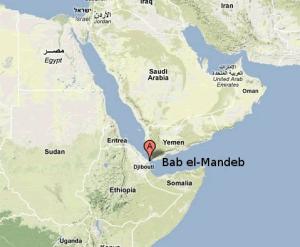Meroë
Bab-el-Mandeb
 Bab-el-Mandeb, which means gate of tears, is the name given to the strait at the southern end of the Red Sea and has been identified as one of the two routes taken by humans ‘out of Africa’ around 120,000 years ago, the other being through Sinai.
Bab-el-Mandeb, which means gate of tears, is the name given to the strait at the southern end of the Red Sea and has been identified as one of the two routes taken by humans ‘out of Africa’ around 120,000 years ago, the other being through Sinai.
The Strait has also been identified by some researchers as the location of the Pillars of Heracles referred to by Plato. This idea is advocated by Jacques Hébert, Thérêse Ghembaza and Sunil Prasannan who have respectively located Atlantis at Socotra, Meroë and Sundaland.
The French historian Philippe Potel-Belner also identifies Bab-el-Mandeb as the Pillars of Heracles(c) beyond which lay Atlantis on a long plain on the west coast of India(b).
>Atlantisforschung has also pointed out that Radek Brychta was another one to nominate Bab-el-Mandeb as the site of the ‘Pillars’(d).<
A fictional account of the destruction of Atlantis in the Red Sea and its relationship with the biblical Deluge by Orson Scott Card is now available on the Internet(a).
(a) http://www.hatrack.com/osc/stories/atlantis.shtml
(b) https://www.academia.edu/3480936/Atlantis_myth_legend_History (French) (offline Nov. 2015)
(c) https://www.academia.edu/3339364/PLATO_revisited_what_he_precisely_said_about_Atlantis (French) (offline Nov.2015)
(d) Säulen des Herakles – Atlantisforschung.de (atlantisforschung-de.translate.goog) *
Ghembaza, Thérêse
Thérêse Ghembaza is a French researcher who has a website, in French and English, entitled The Great Enigmas of Antiquity(a) in which she discusses matters such as the Hyksos, the identity of Moses and the Kushites. The site also deals with her theory that Atlantis had been situated in Meroë on the Upper Nile, a theory that she developed in a number of other papers(c), which are certainly worth a read.
While at first sight this might be seen as a wild claim, Ghembaza offers a well reasoned theory which was presented to the 2nd Atlantis Conference held in Athens in 2008. She has imaginatively linked aspects of Meroitic geography and history with Plato’s story of Atlantis. For example, she identifies Tyrrhenia with Tyre in Lebanon and claims that Tyrrhenia in Italy was a later colony of Tyre! While some of her ideas are convincing I found others a little threadbare. Nevertheless, Ghembaza must be applauded for her efforts to construct a scientific explanation for the Atlantis narrative.
>Although Ghembaza quotes Plato extensively to support her Meroë hypothesis, she fails to explain how an Atlantean Meroë situated on the Upper Nile had territory in Southern Italy and northeast Africa (Tim 25a-b & Crit 114c), a distance of around 4,000 km. Equally difficult to account for is the fact that Meroë did not exist until sometime early in the 1st millennium BC in contrast to the middle of the 2nd millennium, considered a reasonably late date for the destruction of Atlantis. Add to that, the fact that Meroë was never submerged or created ‘shoals of mud’ leaving the credibility of Ghembaza’s Atlantis claims in tatters.<
In April 2015, Ghembaza offered a short paper(d) in support of identifying Bab-el-Mandeb as the location of the Pillars of Heracles.
Ghembaza has kindly drawn my attention to two quotations from Pliny the Elder and Ovid that offer possible explanations for Plato’s orichalcum (see Document 091011). The former refers to a Cypriot copper mixed with gold which gave a fiery colour and is called pyropus, while Ovid also refers to a cladding of pyropus, a term often translated as bronze. She also mentions auricupride(Cu3Au), an alloy that may be connected with orichalcum.
>A lecture outline by Ghembaza with a slideshow can be accessed online(e).<
(a) http://antiqua91.fr/index_en.html
(b) Hecataeus of Miletus‘ Periegesis 550 – 480 “now lost, but probably the main source of Plato and Eratosthenes”
(c) http://antiqua91.fr/atlantis_en.html
(d) See: Archive 2526
Panchaea
Panchaea was an island in the Indian Ocean first mentioned by the Greek philosopher Euhemerus in the 4th century BC. It is conventionally assumed to be fictional(b) as it shares many of the characteristics of Plato’s Atlantis.
>The excellent Theoi.com website(c) offers all the classical references to Panchaea.<
Nevertheless, Thérêse Ghembaza has boldly proposed(a) that Meroë on the Upper Nile, which can be loosely described as an island, was the Panchaea described by Diodorus Siculus and was, by extension, Plato’s Atlantis.
>The Third Atlantis Conference held on Santorini in 2011 saw a paper from geologist Mircea Ticleanou propose that Panchaea had been located on the Pannonian Plain, an idea supported in a 2018 posting(d).<
(a) http://www.antiqua91.fr/panchea_en.html
(b) https://www.jasoncolavito.com/panchaea-the-other-atlantis.html
(c) PANCHAEA (Pankhaia) – Fabulous Indian Ocean Island of Greek Legend (theoi.com) *
